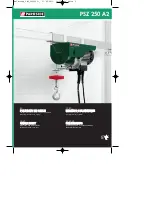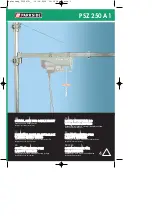
Applying the Load
1)
Do not wrap the hoist rope or chain around
the load.
2)
Attach the load to the load hook securely by
properly rated, suitable mean, such as chains,
shackles, hooks, lifting slings, etc. Load
must be attached to prevent accidental
disconnection.
3)
Properly seat the sling or other device (see
the left side of the diagram below). Do not
allow the hook hitch to support any part of
the load.
4)
Do not apply the load to the point of the hook
(shown in the diagram below on the right
side).
5)
Before moving the load, make sure chains or
wire rope are not kinked or twisted or that
multiple part chains or ropes are not twisted
around each other.
6)
Do not operate the hoist unless rope or chain
is seated properly on the drum, sheaves, or
sprockets.
7)
Do not operate the hoist unless the hoist unit
is centered over the load.
8)
Do not pick up a load in excess of the rated
load appearing on the hoist or load block,
except during properly authorized tests. Do
not use a hoist overload limiting device to
measure the maximum load to be lifted.
9)
Give specific attention to load balancing and
hitching or slinging to prevent load slipping.
Moving the Load
1)
Do not engage in any activity which will
divert the operator’s attaention while
operating the hoist.
2)
Respond to signals from a designated person
only. However, always obey a stop signal no
matter who gives it.
3)
Do not lift or lower a load with the hoist until
the operator and all other personnel are clear
of the load.
4)
Make sure the load with the hoist will clear
all obstacles before moving or rotating the
load.
5)
Do not lift a load more than few inches until
it is well balanced in the sling or lifting
device.
6)
Each time a load approaching rated capacity
is handled, check hoist brake action by lifting
the load just clear of supports and continuing
only after verifying that the brake system is
operating properly.
7)
WARNING! Do not carry any load over
any person.
8)
WARNING! Do not carry personnel on
the hook or the load.
9)
Avoid swinging the load or load hook when
traveling the hoist.
10)
On trolley mounted hoist, avoid contact
between trolleys and between trolleys and
stops.
11)
Do not use the upper (or lower, if provided)
limit devices as a normal means of stopping
the hoist. These are emergency devises only.
Parking the Load
1)
Do not leave a suspended load unattended
unless specific precautions have been
instituted and are in place.
2)
Position the load block above head level for
storage when the hoist is not in use.
3)
Exercise care when removing a sling from
under a landed and blocked load.
Correct and incorrect load hook attachment













